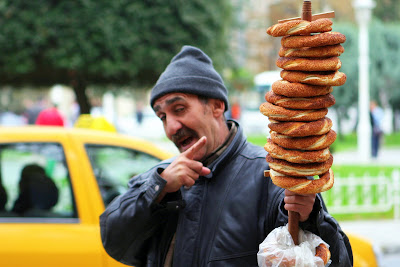The Grand Bazaar in Istanbul is one of the largest and oldest covered markets in the world, with more than 58 covered streets and over 1,200 shops which attract between 250,000 and 400,000 visitors daily. Sprawling over a huge area in the city center, Kapali Çarsi (kah-pah-luh chahr-shuh; "Covered Market") was the first shopping mall ever built. During Byzantine times, this was the site of a bustling market; when the Ottomans arrived, it grew bigger and more diverse. The prime location attracted guilds, manufacturers, and traders, and it grew quickly — its separate chunks were eventually connected and roofed to form a single market hall. Before long, the Grand Bazaar became the center for trade in the entire Ottoman Empire. At its prime, the market was locked down and guarded by more than a hundred soldiers every night, like a fortified castle.
The Grand Bazaar remained Turkey's commercial hub — for both locals and international traders — through the 1950s, its 4,000 shops bursting with everything you can imagine, from jewelry to silk clothing, and traditional copperware to exotic, Oriental imports. But then the Grand Bazaar was discovered by travelers seeking the ultimate "Oriental market" experience. Prodded by shopaholic tourists with fat wallets, prices and rents skyrocketed, and soon modest shopkeepers and manufacturers found themselves unable to compete with the big money circulating through the bazaar's lanes. These humble merchants moved outside the bazaar, displaced by souvenir and carpet shops. Today's Grand Bazaar sells ten times more jewelry than it used to. And, while tourists find it plenty atmospheric, locals now consider its flavor more Western than Oriental.





Taksim Square (Turkish: Taksim Meydani) situated in the European part of Istanbul, in Beyoglu district, is a major shopping, tourist and leisure district famed for its restaurants, shops and hotels. It is considered the heart of modern Istanbul is the most known modern city center of Istanbul. Istiklal pedestrian street has many bars, night clubs and movie theatres therefore it's always busy with young people almost for 24 hours a day. The Square is also the meeting place to celebrate New Year's Eve, parades, public concerts and other shows.
Food

Dessert

Baklava

Fancy Street Restaurant

Clams

Fried Oyster

Fruits

Meat

Fish

Pubs

Keen for a drink?

Live Entertainment along street pubs

Kebab

snack

Anyone for kebab and Pomegranate juice

Another cafe



.JPG)














.JPG)















































